
PREV ARTICLE
NEXT ARTICLE
FULL ISSUE
PREV FULL ISSUE
STACK'S BOWERS AUGUST 2018 AUCTION SELECTIONSHere are several lots that caught my eye in the upcoming Stack's Bowers ANA World's Fair of Money sales. -Editor 1781 Daniel Morgan at Cowpens Splashers  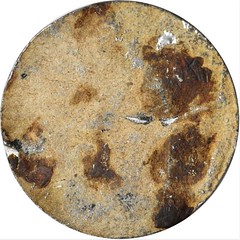 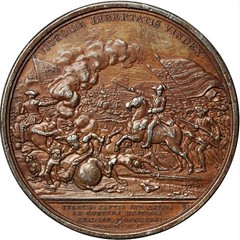 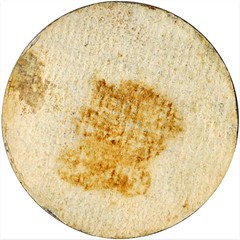 1781 Daniel Morgan at Cowpens Obverse and Reverse Splashers. Uniface. White Metal Backed With Paper. 56.4 mm. 22.56 grams and 34.30 grams, respectively. Adams and Bentley-10, Betts-593, Julian MI-7. Mint State. The medal awarded to Daniel Morgan for his rout of the British at Cowpens is a tour de force in the Comitia Americana series, its fabulous Dupre designs and die work considered to be his second best after only the ever popular and beautiful Libertas Americana medal. The intricate reverse (actually intended as the obverse) shows a mounted Daniel Morgan leading the cavalry charge that helped defeat the better trained and similarly sized British force under Lieutenant-Colonel Banastre Tarleton at the Cowpens in South Carolina. Dupre's scene of horses, troops, bodies, smoke, flags and carnage is unmatched in the Comitia series; the design of displayed eagle on the Americans' standard on this medal produced in 1789 presages Dupre's design of the 1790 Diplomatic Medal. Although traditionally offered as individual objects, the current set is being offered as a beautiful pair of epreuves of the completed obverse and reverse designs, created by impressing the dies into molten metal poured onto scrap paper, the remains of which are still visible on the blank backs of both pieces. Remains of wax or epoxy or also on the backs of both, as they were perhaps mounted to a display at some juncture in their 230 year existence. The obverse splasher, or cliché, is notably thinner, its surfaces a pleasing medium gray with natural lacuna from thin tin, chiefly below the exergual line where the pour must have been thinnest. This delicate object is quite straight, though with slight waves through MORGAN and through the periphery around the 5 o'clock position. Its back shows some of the bright metal where the paper backing has been scraped away. The reverse splasher, or cliché, is notably thicker than the obverse, with a coating of protective lacquer on its face that gives the initial impression of a bronze specimen. Light handling marks are noted chiefly along the rims, and some lacuna in the metal are noted around the 3 o'clock position. Amazing artifacts from the classic series of medals commemorating events of the American Revolution. -Editor To read the complete lot description, see: 1865 New York State Volunteers Medal 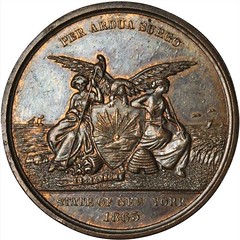  1865 New York State Volunteers Medal. Bronzed Copper. 37.4 mm. Julian MI-32, Vernon US-475. About Uncirculated. Struck to be presented to volunteers from New York who served in the Army or Navy during the Civil War, this one not inscribed with a recipient's name. An important medal in that R. W. Julian in his encyclopedic Medals of the United States Mint described this previously unknown medal from only fragmentary information in Mint records. He could only note the size and that the obverse was dated 1865 and the reverse inscription began with PRESENTED TO. Here is the complete description. Obv: An eagle surmounted Seal of the State of New York with PER ARDUA SURGO above, STATE OF NEW YORK / 1865 below. Rev: A 14-line inscription PRESENTED TO / (blank) / BY R. E. FENTON, / GOVERNOR / OF THE STATE OF NEW YORK. / IN PERSUANCE OF / CONCURRENT RESOLUTIONS / OF THE / LEGISLATURE, / AS A MEMENTO / OF THE / COURAGE AND FIDELITY / WITH WHICH HE HAS SERVED / THE STATE, / DURING THE WAR OF THE REBELLION. Choice semi-reflective surfaces still displaying some of the original mint red. The planchet and surfaces with no problems of note. An interesting consideration is that this medal is valued at $1,000 in Sidney B. Vernon's Collectors Guide to Orders, Medals and Decorations, Fourth Revised Edition (2000), the latest edition, although still 18 years old as of this writing. To read the complete lot description, see: 1871 George F. Robinson Medal   1871 George F. Robinson Medal. Silver. 76.8 mm. 3,613.5 grains. By Anthony C. Paquet. Julian PE-27. MS-63 (NGC). Witness line at 8:45. Both the obverse and reverse of this piece are a beautiful silver gray with iridescent gold overtones and a few areas of blue and rose, principally around the peripheries. The centers are very sharply struck and the dramatic rescue scene on the reverse is bold and clear. The rims are undamaged and the edge is sound. Extremely rare: one of just two struck in silver sometime between 1874 and the first half of 1875. This medal was voted by Congress in gold for Robinson's preventing the assassination of Secretary of State William Seward at the hazard of his own life. Robinson's gold medal was received by the Smithsonian in 1947. To read the complete lot description, see: So what's a "witness line"? Dick Johnson's dictionary doesn't include this term. A search of the Newman Numismatic Portal reveals many instances of it. One definition is a "collaring mark from a bipartite collar". A 1979 (Vol. XLIX) British Numismatic Journal article by Marvin Lessen on the Cromwell Lord General Medal by Simon notes, "The edge of most specimens shows distinct witness-line traces of the steel band used in conjunction with a surrounding collar during striking..." -Editor I reached out to Dick Johnson, who writes: This is what Americans call "Collar Gap" which is a far more descriptive term. Collar Gap. The space between the segments of a segmented collar and the resulting line on the edge of a coin or medal struck from such a collar.
The line runs across the edge (perpendicular to the obverse and reverse), and sometimes all three lines may be present — proving it was struck from a trisegmented collar. These
lines will be equidistant from each other. Collar gaps are found on some U.S. Mint medals of the 19th century. Below is text from Roger Burdette's From Mine to Mint, which incorporates another usage. (Thanks, Roger!) -Editor Infiltration — This was the process of filling the crack or other defect with hard material such as steel wire. The infiltration could be locked in place by mechanical means, such as undercutting and packing, or by welding the filler in place. In either event, considerable surface smoothing had to occur. This was difficult to apply to small cracks and would usually not withstand significant heat treatment. Even after successful post repair machining has been completed, a "witness line" which resembles shrinkage lines can be noted between the repair and the adjacent die steel. This can, if excessive pressure is used, result in a die crack propagating from the witness line to a weak point in the die. It's the line or junction between a repair and adjacent steel or at the junction of two pieces of metal. It comes from the idea that the "line is a witness" to the repair. "1861" (1891) State of Pennsylvania First Defenders Medal of Honor Obverse Struck on an 1861 Liberty Head Double Eagle 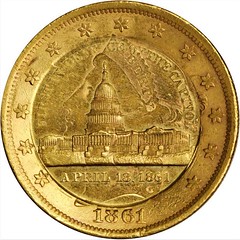 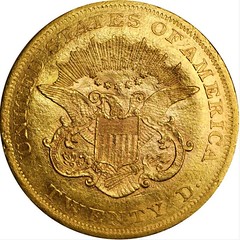 Impressive Pennsylvania First Defender's Medal Obverse Struck over an 1861 Double Eagle "1861" (1891) State of Pennsylvania First Defenders Medal of Honor Obverse Struck on an 1861 Liberty Head Double Eagle. 34.9 mm. 33.4 grams. Mint State. On April 15, 1861 President Abraham Lincoln put out a request for volunteer soldiers to participate in the battle against the Southern secessionists. Thousands quickly responded to this request, but the first group to reach Washington was composed of some 500 Pennsylvanians of the Ringgold Light Artillery of Reading, the Logan Rifles of Lewistown, the Allen Infantry of Allentown, and the National Light Infantry and Washington, both of Pottsville, all of whom arrived in Washington - not without difficulties - three days later during the evening of April 18, 1861. Celebrated at the time for their quick response, these volunteers were to continue to receive accolades long after the Civil War had ended. Thirty years later, on May 26, 1891, the Pennsylvania State Legislature proposed another honor for the First Defenders, and an appropriation for "Medals of Honor" for the First Defenders be made. As quoted from the proposition, "Be it Enacted, That the sum of one thousand five hundred dollars, or so much thereof as may be necessary, is hereby specifically appropriated for the purpose of procuring a suitable medal with commemorative devices, for each of the surviving members or their heirs, of the National Light Infantry of Pottsville, Pennsylvania; the Washington Artillerists of Pottsville, Pennsylvania; the Reading [Ringgold] Artillery, of Reading, Pennsylvania; the Allen Infantry, of Allentown, Pennsylvania; and the Logan Guards of Lewistown, Mifflin County, Pennsylvania, to commemorate the event of the said five companies being the first to respond to the call for troops by President Lincoln, of date April 15th, one thousand eight hundred and sixty-one, mustered in at Harrisburg, Pennsylvania, on the 18th day of April one thousand eight hundred and sixty-one, and reached Washington, District of Columbia, and were stationed in the Capitol building for its defense on the 18th day of April, one thousand eight hundred and sixty-one." Quickly approved by the State Legislature, the medals were soon designed and struck. The original medals were a complicated affair composed of a 24 mm bronze medal inserted into a 38 mm radiant Greek cross. The cross was suspended by a loop at the top from a red, white, and blue silk ribbon - which in turn was attached to a bronze pin-back hanger embellished with the Pennsylvania State Seal and the words FIRST / DEFENDER to the left and right. Long regarded as one of the most desirable of Civil War medals, this original award is rarely seen today. The present piece is a regular issue 1861 Liberty Head double eagle with the obverse of the central medallion of the First Defenders cross stamped onto its face. It features a view of the United States Capitol Building (as it appeared in the late 1800's) with the inscription FIRST IN DEFENCE (sic) OF THE CAPITOL above, and APRIL 18, 1861 below. Many times rarer than the original medal - of which it is thought that only 127 of the possible 475 First Defenders (or their heirs) actually received - this piece is very likely a one-of-a-kind example. The stamping is nicely centered, with the 1861 date of the original coin quite clear, and a shadowy image of the original Liberty Head still detectable in the fields. The reverse of the original coin is completely visible, although flattened a bit in the center, opposite the medal stamping. The host coin is nearly a full millimeter larger than a normal Liberty $20, a result of the stamping of the medal design. Another of the many wonders of numismatics. Just when you think you've already seen eveything, something like this comes along. If only we knew more about its history - when was it struck, and for whom? -Editor To read the complete lot description, see: 1859 Indian Cent 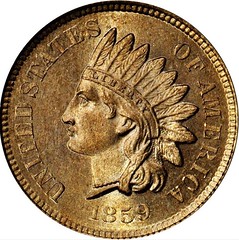 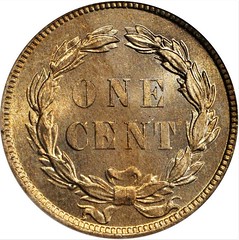 1859 Indian Cent. MS-66 (PCGS). CAC. James Barton Longacre's widely collected Indian cent made its debut in 1859 with a mintage of 36,400,000 circulation strikes and approximately 800 Proofs. The obverse portrait, in fact, is not that of a Native American but rather a representation of Liberty wearing a feathered headdress. The artist's original concept for this design made its debut in 1849 on the gold dollar, and subsequently went through various refinements (including on the three-dollar gold piece first issued in 1854) before appearing on the Indian cent. The reverse of the 1859 cent exhibits a simple olive wreath without a shield at its top, a design that was abandoned in 1860 in favor of the Oak Wreath with Shield design. (The olive wreath has gone down in numismatic literature as a laurel wreath due to Mint Director James Ross Snowden's designation from 1860.) The 1859 Indian cent, therefore, is a one year design type that is eagerly sought by today's collectors. Fortunately, many 1859 Indian cents have survived in Mint State, yet on the other hand most are poorly defined due to the Mint's widespread use of worn dies in production of this issue. A beautiful example. -Editor To read the complete lot description, see: 1955 Doubled Die Obverse Lincoln Cent 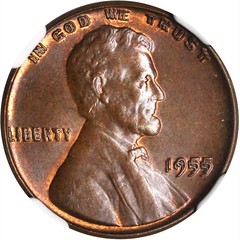 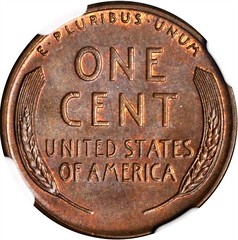 1955 Lincoln Cent. FS-101. Doubled Die Obverse. MS-65 BN (NGC). CAC. The story of the 1955 Doubled Die Obverse Lincoln cent was first told in detail by our own Q. David Bowers in 1964 in his first book, Coins and Collectors, but is worth repeating in summary here: In 1955 Jim Ruddy (who in 1958 became Dave's partner in the Empire Coin Company in Johnson City, New York), was shown a Lincoln cent with curiously doubled letters and numbers on the obverse. He found it interesting, and bought it for 25 cents. This attracted the attention of a newspaper writer who interviewed Jim, and he said he would pay a quarter each for all offered. After a couple dozen came in he rescinded his offer. It turns out that nearly all were found in cigarette packs. The price of a pack in a vending machine was 23 cents at the time. Anyone inserting a quarter would get a pack of cigarettes with two bright Lincoln cents under the cellophane on one side. At that time there was very little interest in mint error and die error coins. That did not happen until some years later when Frank Spadone, a New Jersey dealer, published a booklet on the subject and, also a bit later, Michael Kolman, Jr., of the Federal Coin Exchange in Cleveland, advertised and displayed struck mint errors (as opposed to error dies). Now in 2018 interest is intense in such fascinating die varieties, mainly propelled by the standard work on the series, Cherrypicker's Guide to Rare Die Varieties by Bill Fivaz and J.T. Stanton. Dave contacted the Philadelphia Mint and spoke with the person who was involved. It turned out that on one particular day multiple presses were striking 1955 Doubled Die cents. Someone examining a bin in which the output for the presses had been dumped noticed a "freak" coin with blurred lettering. The press was identified and the offending die replaced. By that time the press had struck 40,000 pieces, 24,000 of which had been mixed with other coins and were sent out for regular distribution, there being no particular reason to save them. The others, still in a bin at the press, were destroyed. Thus, the net production amounted to about 24,000 pieces. In time, we believe in about a year, the variety was published, called the 1955 "Shift cent" by some. It was not until a few years later that it was listed in A Guide Book of United States Coins, at which time Ken Bressett assigned the designation Doubled Die, which has since been applied to many varieties in other series. The coins caught on, became worth several dollars, and then even more. A classic U.S. variety, always popular yet available in the marketplace due to the relatively large population. -Editor To read the complete lot description, see: 1796 Draped Bust Cent Struck 65% Off Center, Cut Down and Overstruck  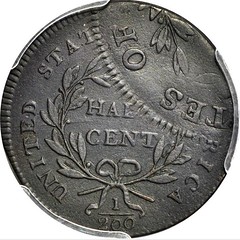 Extremely Rare and Famous 1796 NC-7 Draped Bust Cent Overstruck by a 1797 C-3b Half Cent Just Two in Private Hands 1796 Draped Bust Cent--Struck 65% Off Center, Cut Down and Overstruck by 1797 C-3b Half Cent Dies--NC-7. Rarity-8. EF Details--Environmental Damage (PCGS). This famous rarity has been the object of considerable debate among early copper enthusiasts regarding the order of striking, i.e. whether the initial impression came from the half cent or cent dies. PCGS has certified this coin as a 1797 C-3b half cent (coin #35113), the insert stating: "O/S by 1796 NC-7." Since its discovery in 1994, however, the general consensus has been that this coin started as a 1796 Draped Bust cent that as struck 65% off center, the planchet subsequently cut down and overstruck by 1797 C-3b half cent dies. Indeed, this is how John Whitney Walter collected this coin, and it is how it is listed in the census of known examples in Walter Breen's Encyclopedia of Early United States Cents: 1793-1814 (2000) and on the PCGS CoinFacts website. This coin has also been cataloged as a 1796 NC-7 Draped Bust cent in our (Bowers and Merena's) Herman Halpern Collection sale of March 1995, and in our (Stack's) subsequent offering of the John Whitney Walter Collection of Coins of 1796 (May 1999). Here's the census of the three known examples. -Editor 1- PCGS EF Details--Environmental Damage. Ex our (Bowers and Merena's) Herman Halpern Collection sale, March 1995, lot 2307; our (Stack's) sale of the John Whitney Walter Collection of the Coins of 1796, May 1999, lot 1758. The present example, unattributed when consigned to Bowers and Merena in October 1994, the attribution determined by March Borckardt and confirmed by Denis Loring and Dr. John Kleeberg. 2 - EAC Good-6. John P. Kennedy; George H. Clapp, March 1928, discovered in the Kennedy Collection and described by Clapp in The Numismatist, Vol. XLI, 1928, p. 315; B. Max Mehl, privately; "Colonel" E.H.R. Green; Burdette G. Johnson (St. Louis Stamp & Coin Co.), April 1946; George H. Clapp; ANS Collection. 3 - EAC AG-3. Purchased attributed by Rod Burress, 1999; Daniel W. Holmes. Jr., 1999.In summary, this is one of just two collectable examples of this Rarity-8 1796 NC-7, a coin that combines both great rarity and importance for numismatic history. There is some disagreement in the copper community over how this coin was actually struck. Many believe that the 1796 NC-7 cent came first and that the 1797 half cent is struck over the cent, as described here. Others believe that the large cent is struck over the half cent. Simply looking at the coin, even under high magnification, does not completely answer the question of which came first, the half cent or the cent. For example, Breen noted that it was not possible to figure out whether the 1796 S-115 cent or the 1797 half cent came first on the piece Frank Stewart found when his men demolished the first mint building site (published 1916 in The Numismatist). Luckily for numismatics, Ron Landis of the Gallery Mint Museum consented to try an experiment. With the present coin before him as a guide, and using dies of his own making, Ron struck sample coins both ways. First, he struck 1796 large cent dies off center onto a planchet, then cut the off center struck large cent down to half cent planchet size. He then lettered the edge with a half cent legend, and then used the off center strike as a planchet for his 1797 half cent dies. Next, he struck a centered, edge lettered 1797 half cent and then using that coin as a planchet struck it off center with the 1796 large cent dies he had made. Finally, Ron placed one each of his sample coins alongside this NC-7 and compared them. There was no question any more as to which came first. The large cent was seen to have been struck first, off center, and this "spoiled cent'' (as Breen called them) was used as a planchet for the 1797 half cent. This coin presented a fascinating technical puzzle (or was it riddle, wrapped in a mystery, inside an enigma)? This is what makes error coin collecting so interesting - it's a crash course in the coin manufacturing process, and I would say you can't call yourself a true numismatist without a solid understanding our how these objects are made. Would anyone have any images of the examples Ron Landis made for this study? -Editor To read the complete lot description, see: 1943 Lincoln Cent Overstruck on a 1943 Mercury Dime  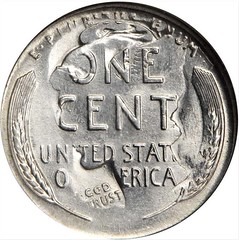 Remarkable 1943 Lincoln Cent Overstruck on a 1943 Mercury Dime This intriguing and rare double denomination error is ranked No. 39 in the popular reference 100 Greatest U.S. Error Coins by Nicholas P. Brown, David J. Camire and Fred Weinberg, where it is described as: "A breathtaking coin to see, this double denomination combines the popularity of not only the Lincoln cent and the Mercury dime, but also the 1943 date (caused by the desirability of the famous 1943 copper cents....). This example, like other wrong-planchet, off-metal strikes, resulted from overlooked coins being left in tote bins. From there it was a simple matter for this dime to be mistakenly fed into a press coining cents. "This nice brilliant Uncirculated specimen is one of two known for this date and series, and it shows excellent details of the original dime impression. In this case, the obverse cent design is on the reverse of the dime, and vice versa. This was entirely a random matter, and it just as easily could have been coined in the other orientation. "As has been previously noted, off-metal error coins are very popular. The 1943 error coinage carries special collector interest due to the publicity surrounding the 1943 bronze cent. There are not many 1943 cents struck on dimes. In high grades they always command a premium." To this excellent write up we would add very little other than to report that the other known example of a 1943 cent overstruck on a 1943 dime appeared in our (Bowers and Ruddy's) Terrell Collection sale of May 1973, lot 1092. For that coin, the obverse and reverse of both types were aligned. On the present example, portions of all four digits in the date for the Mercury dime are discernible within the lower portion of the right wheat ear. Special thanks to Saul Teichman for providing us with census and provenance information relating to this significant Mint error. Another fabulous error coin. Who wouldn't want to have this one? -Editor To read the complete lot description, see: 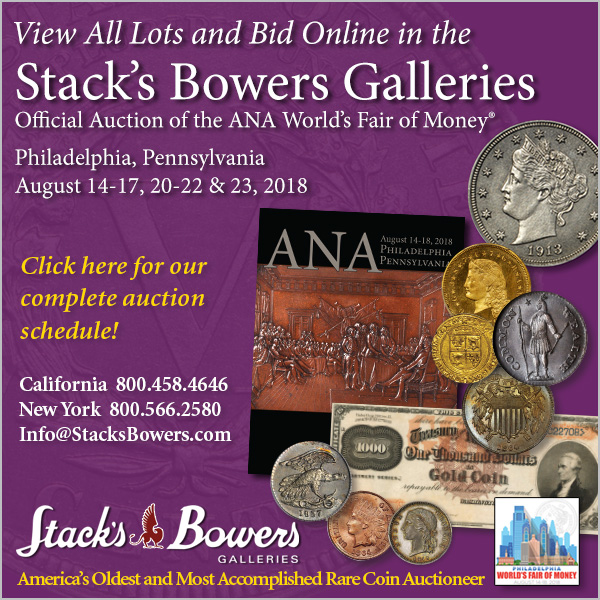 Wayne Homren, Editor The Numismatic Bibliomania Society is a non-profit organization promoting numismatic literature. See our web site at coinbooks.org. To submit items for publication in The E-Sylum, write to the Editor at this address: whomren@gmail.com To subscribe go to: https://my.binhost.com/lists/listinfo/esylum All Rights Reserved. NBS Home Page Contact the NBS webmaster 
|